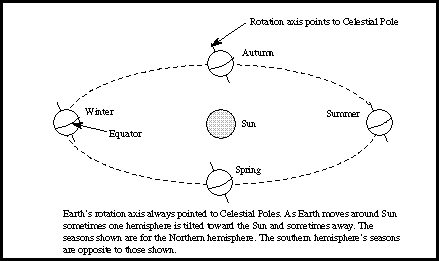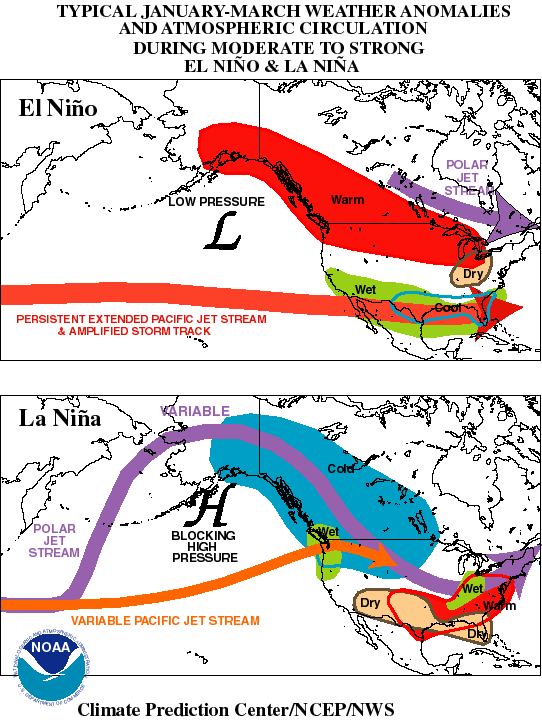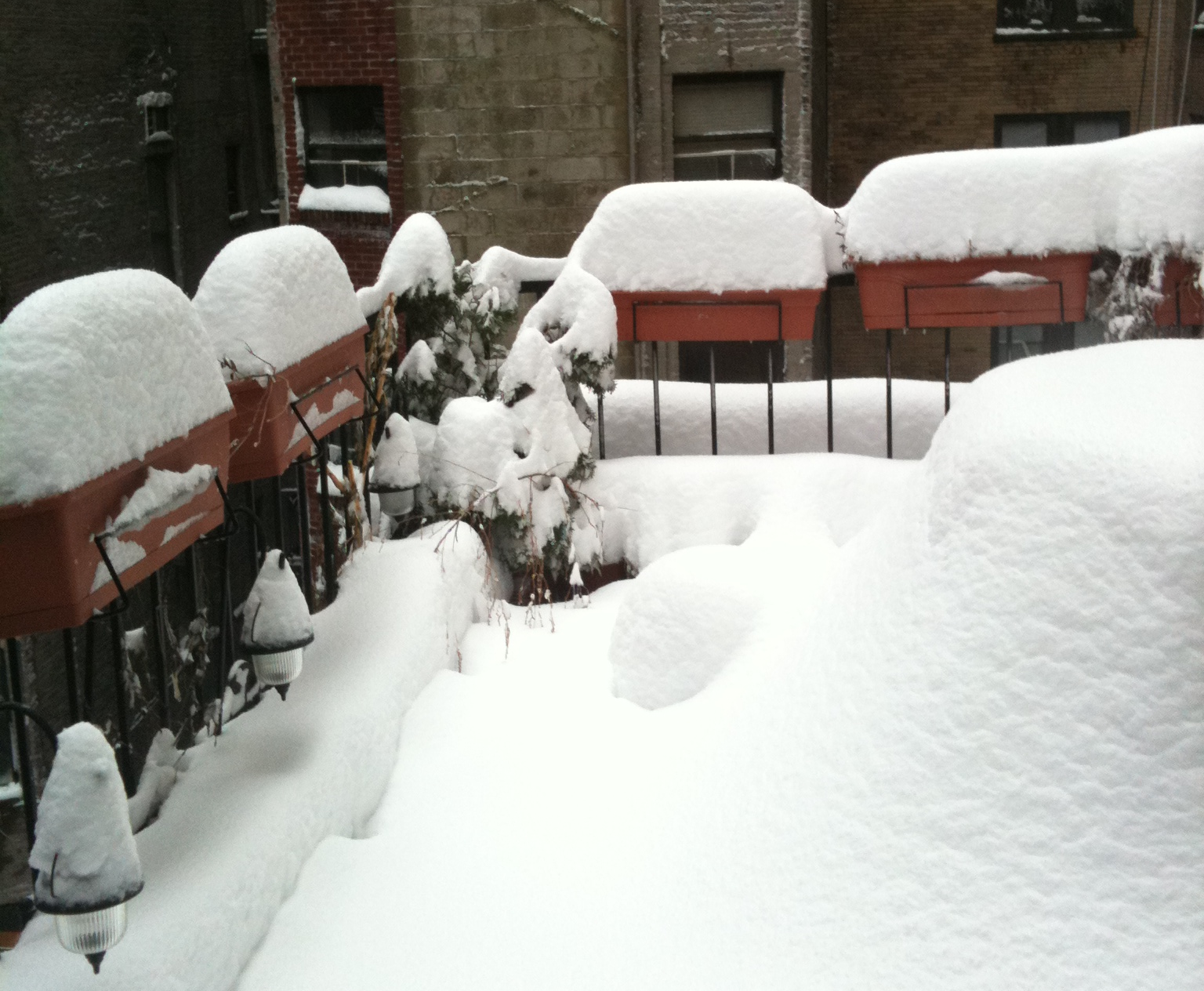It is a snow day in New York City. Again. I am enjoying it but I did grow up in Montana. This one is a little closer to what I would call a snow day, i.e. a decent accumulation where I would be tempted not to use “rock skis”. While I understand why folks (including Marj) are getting tired of this weather, it still brings a smile to my face and joy to my heart.
I am annoyed at and tired of people who use today’s weather here in NYC (and for reasons that are not good, if it is a slow news day, NYC’s weather will become national news) as evidence that the planet isn’t warming, that the climate isn’t changing, that Al Gore and climate change are all a left-wing conspiracy, et yada, yada, yada.
If you have been following this area of research as long as I have (since college in the early 1980’s) you may have noticed one interesting trend from the reality deniers. As the evidence mounts and the modeling of weather and global climate has advanced, the reality denier argument has shifted towards the trivial. From questioning
- if there is a CO2 greenhouse effect (yes there is);
- whether or not is CO2 rising (yes it is);
- is the average global temperature rising (yes it is with November 2009 and January 2010 as the warmest on record);
- are humans causing the rise in CO2 (straw man argument – burning fossil fuels is a major contributing factor and one of our few controllable factors but it doesn’t matter if we are causing it, only if we can do something to slow it down or better reverse it);
- the integrity of the research because of one email about bad data in one study and ad homimen attacks on vocal advocates like Al Gore and the most recent (when there is no evidence on your side attack the messenger);
- “It’s snowing in New York City” (makes a nice sound bite).
Well duh! If you have been paying attention to the data, the climate and weather model forecast for this winter have been spot on. They predict a cold and snowy winter for the northeast through March (sorry to bare cold tidings).
So how does snow happen in New York City if the planet is getting warmer? Fair question.
Let’s start with the concept of second order effects. This is a mathematical term familiar to anyone with advanced training in a field that uses statistical or other mathematical modeling (physics, econometrics or as it happens climate modeling). In simple terms, it is when A causes B to happen and then B causes C to happen. The B to C causality is the second order effect. For most of us in our daily lives, these second or even third order events are what we usually think of as unintended consequences.
Weather and climate are systems. That means that A causes B which influences C which affects D and E and E affect B and D and C affect A. So, what is causing it to snow in NYC today is too simple of a question. The better question is how can a greenhouse climate change model explain today’s snow in NYC?
So let’s get into the details.

This image shows the cold air from the north and the warm air from the south as well as two jet streams between them. The top one is the Midattidute jet stream and the bottom one is the Subtropical jet stream.A fuller description is available at www.weatherquestions.com where this graphic is from.
If you pay attention to weather maps, you should know that the weather pattern for temperature across North America is defined by the jet stream. North of the jet stream is cold and south of the jet stream is warm. How far south the jet stream meanders is related to the strength of the wind in the stratosphere (which is the jet stream). The faster it goes (up to 250 knots), the further north it stays (and the cold weather with it). The strength of the jet stream is defined by the temperature of the air in the stratosphere. This is known as the Arctic Oscillation. The larger the temperature difference between the two air maases, the stronger the jet stream. Typically in winter, the colder the stratosphere above the Arctic, the stronger the jet stream. The warmer the air, the weaker the jet stream (and the colder the weather is in NYC).

This graphic depicts what was considered the normal jet stream patterns over North America. This graphic is about weather systems at http://www.fas.org/irp/imint/docs/rst/Sect14/Sect14_1c.html.
The map on the right of this paragraph shows the jet stream for 26 February 2010. Notice how far south it is coming off the Rockies i.e., Texas when Nebraska would be a more typical recent pattern. Also notice where it is coming back north far out in the North Atlantic. A warmer pattern has the jet stream coming up along the coastline. Note that the wind speeds are around 120 knots, half of the top speed.
So because of warm air in the arctic stratosphere, the jet stream is weak allowing cold air to move south from the arctic making it snow in NYC.
But it is the Arctic. In winter! The sun isn’t shining! So where is the warm air coming from?
Well, it turns out the warm air is coming from the Pacific Ocean. Primarily from the South Pacific which is in the middle of a strong El Niño event (when the water temperature of the South Pacific of South America warms up, warming the air above the surface of the ocean). But El Niño isn’t the point. The warm air from the Pacific moves north along the western Pacific (just like the Gulf Stream in the Atlantic). To the right is a map of the jet stream over the northern Pacific. When this pattern hits the continent further north is when Seattle is usually rainy and San Diego is a desert. This winter, because of the strong El Niño, it is dry in Vancouver and wet in San Diego. Typically this winter, the warm air mass is reaching Alaska.

This graphic portrays how the sun’s energy along with the axial tilt of the Earth creates the seasons. (The source of this graphic is Nick Strobel’s Astronomy Notes. Go to his site at www.astronomynotes.com for the updated and corrected version.)
The South Pacific is currently being directly hit by the rays of the sun. Remember, it is summer down there. The most energy from the sun is absorbed by the Earth when the rays strike the Earth perpendicular to the atmosphere and the surface, which is part of the reason why summer is warmer than winter. Remember the angle of the Earth’s rotation on the orbital plane? Look at the graphic on right for a reminder or go to Astronomy Notes for more detail.

Notice how the jet streams vary between the extreme patterns know as El Niño and La Niña.
So, the sun warms the water of the Pacific Ocean which warms the air above the ocean which moves north and warms air in the arctic stratosphere, the jet stream is weak allowing cold air to move south from the arctic making it snow in NYC. The image to the right depicts two weather pattern extremes, the El Niño and the La Niña events. Both are becoming more common. Notice how the temperature of the Pacific affects the Arctic during both events.
To this point we are describing normal patterns that have have most likely occurred for millennium (though we have not be able to directly observe or record this data until recently). This is where the greenhouse effect comes into play. Because of the increased levels of CO2 and other greenhouse gases, more of the heat from the sun stays in the Pacific Ocean and does not radiate back into outer space. Just like the glass of a greenhouse traps the heat inside the building, so does CO2 keep some of the heat from the sun from radiating back into space. So, the Pacific Ocean is warmer year to year and more likely to stay warmer seasonally, which is the data that allowed the climatologists to predict that this year would be cold and snowy in NYC probably last well into March.
Note the change in language in the previous paragraph. It is one of scope. Previously we were talking about weather patterns, how warm water in the Pacific causes warm air in Arctic stratosphere causing snow in NYC. These patterns are made up of cycles that run for decades. In the last paragraph we are starting to talk about how changing some factor in the cycle and you change the patterns.
My guess is that the next factor to change in the pattern that affects winter in NYC is the average temperature of the Arctic. As the Arctic warms up and the ice cap grows smaller, the cold air moving south will be warmer. The temperature in NYC during this year’s snow storms has been right around freezing. Two to three degrees F warmer and all this snow would have been rain. We haven’t been anywhere near really cold weather for years. In fact, that is why we haven’t had much snow.
So, this cold snap, has been more about how long it has been cold than how cold it has been. And I can not help but wonder what the tipping point is for the arctic ice cap and the melt begins in earnest. But that is all off point.
The issues facing us today are complex. Actually, they have always been, but we have reach an evolutionary point in our development as a sentient organism where we can appreciate complexity, understand it and more importantly start to make decisions based on complexity and not on bumper stickers.
The Earth and the Universe will continue on without us. Personally, I would like to see sentient life on Planet Earth start to make some smarter decisions and hopefully stay around a while longer.
————-
Graphical depictions and more information about the physics of the seasons from Astronomy Notes:
- http://www.astronomynotes.com/nakedeye/s7.htm
- http://www.astronomynotes.com/nakedeye/s10.htm
Graphical depiction of the global jet streams from Stormsufing.com.
More information about the jet stream at www.weatherquestions.com.
More information about El Niño and La Niña.

